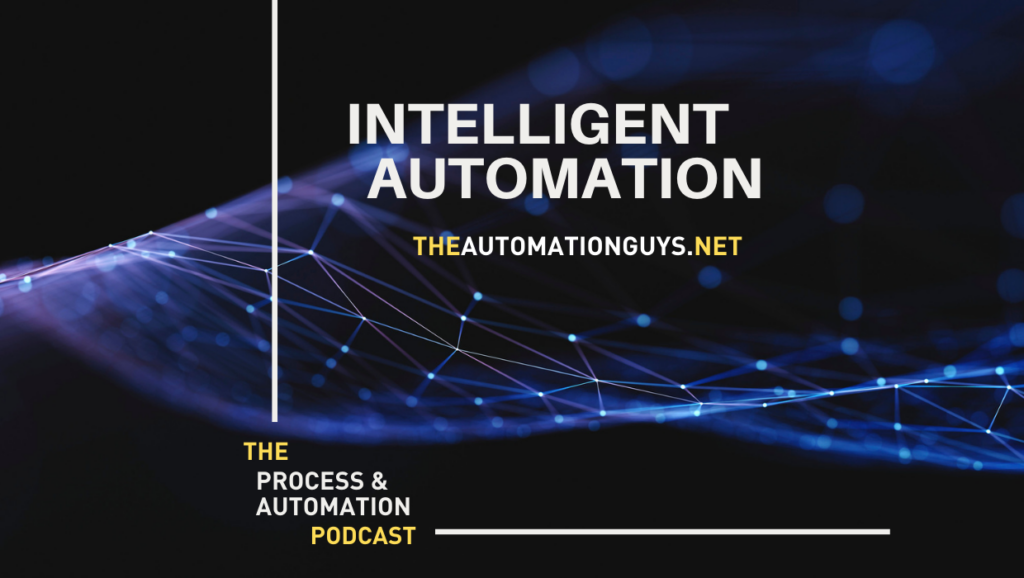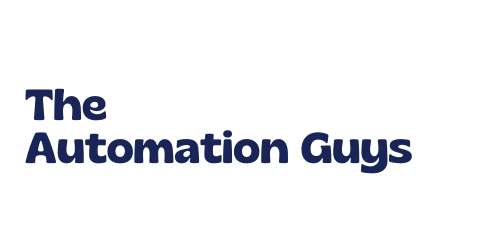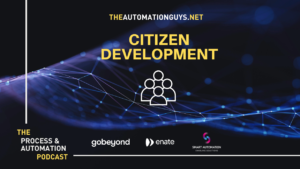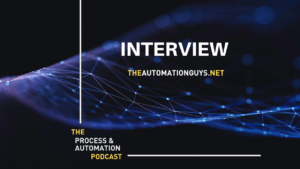Blog

#54 The squeaky chair episode....Is RPA difficult to learn?
It is now simple and easy to get started with RPA! In this episode, The Automation Guys discuss how to become proficient in the basics of RPA very quickly.
Listen now to discover The Automation Guys RPA sandbox.
Join The Automation Guys community and get access to a fully functional robotic process automation environment. Let’s automate it!
Share This Post
The #1 source of knowledge for everything automation: https://theautomationguys.net
Do you have any questions? Would you like to give us feedback? Are you interested in workshops on the topic of automation? Are you an expert in the field of automation and would like to be on the podcast? Let us know: https://bit.ly/3lyq9Yj
Episode Transcript
Sascha: Welcome to another episode of The Process and Automation podcast. I’m Sascha Cutura and with me, as always is Arno Van Rooyen and together, we are The Automation Guys and all our listeners out there know, we are extremely passionate about all things automation. And we can’t stop recording on new episodes and today, Is again, a bit of a premiere since we started the podcast last year, recorded all episodes apart from each other via zoom, which worked very well.
But today we are recording it here in London, uh, in a meeting room. So it’s really, really exciting to, to do this together for the first time and with that we welcome you to another, RPA episode. Um, and as we know, there are huge numbers of enterprises out there who already experimented with robotic process automation, and they have great use cases, very nice successes, but scaling this up very often, is still a challenge. But as RPA starts to become more and more, um, like a commodity understand the tool sets, so I think we mentioned it last year already. So Microsoft started to put this on, on everyone’s machine, hence, uh, everyone is a bit more focused on that and everyone wants to get onto that, that automation training as well. So, um, but here on the podcast, um, and the feedback we get over and over again, we get asked how easy is it actually to learn RPA on where to start and how to make it a success. So Arno let’s kick it off.
Is RPA difficult to learn?
Arno: Um, thank you, Sascha. And it’s, it’s good to be in London today. Uh, doing a face-to-face recording. Um, the bottom line is RPA is not difficult to learn as it doesn’t require any programming knowledge to get started. So common RPA tools like your Uipath, for example, can be used by recording tasks, without any coding.
And you know, if you have advanced tasks that you’re require with inside your robotic sequence, as they call it, You know, some limited programming skills are required. Um, RPA is probably one of the easiest technologies to get, you know, basic grip or grasp off in next to no time and, you know, build up skills very quickly.
You know, you could use it regularly to automate many of the computer task you previously had to do manually. And this saves a lot of times this is responding to emails, creating spreadsheets, management reports, little things like that, that you have to click around and scrape data from various systems.
So RPA really takes that burden away and speeds that up and really make your day a bit more productive.
Sascha: Hmm. All right. Yeah. Then let’s have a look at, uh, some of the reasons why RPA, is not too difficult to learn. Um, so to start learning about RPA that’s the first big part. You don’t need to be a programmer.
You don’t, you don’t need to have programming skills or sort of development knowledge. A lot of people who work with RPA tools and software are actually not programmers as they, um, use RPA to automate sort of the tasks they are doing manually, and of course, as I mentioned earlier, that saves a lot of time.
Arno: Yeah, and I guess, you know, RPA is easier to learn than other technologies.
Um, we find that RPA as a sort of a lower learning curve to understand it’s underlying principles. And to become proficient in some of the RPA software to a level where you can actually use it in real life, um, automation, tasks that you want to obviously automate, um, you know, it’s, it’s quite easy. RPA is software that’s designed for normal people to use as well as advanced users and developers.
And, um, you know, there is intuitive ways, um, built into the actual RPA software that makes it really easy, you can become a proficient in the basics of RPA very quickly. If you spend a few hours a day, um, you know, over a couple of weeks, um, RPA software is what we call low-code software and it uses, uh, a lot of drag and drop functionality.
We talk a lot about that in the podcast. And that really allows you to create these, these automated tasks by dragging activities into, uh, what’s called sequences, um, you know, with, with the RPA software. And that then creates your automation script for, for, you know, for, for effectively your workflow that you wish to execute.
And this could be something where you receive an email and you need to scrape a data from the email and you need to go enter that into various systems and send a response email out. Um, so this makes it really easy to quickly turn a manual task into an automated one without needing to, to write any code to do so.
So overall, I would say getting to a basic level of proficiency, take very little time, you know, all because the learning curve required, isn’t really that steep in compared to other technologies.
Sascha: Yeah, indeed. To, to graph the fundamentals of RPA it is very easy, indeed. Um, um, yeah, the allows you actually, um, very quickly, um, uh, sort of progress very quickly and using the software to automate a lot of software you use on a daily basis, like your Excel or outlook, or maybe your finance tool.
Um, Yeah. And it’s also fundamental to differentiate between an activity. Um, Arno mentioned the sequence, uh, and to differentiate between the activity and the sequence, um, and, and sort of sort of triggers sort out a few sort of terminologies and RPA, you need to just understand, but once, once you get used to it, um, so you can build, build things very easily.
Um, but basically you’re you, um, Sort of, um, look at your work you’re doing and slicing and a lots of activities, like a mouse click, and I’m moving the mouse to, to a certain place and click on the specific application. So, so with all those kinds of various specific things, which are very common in all sorts of RPA software tools, um, So then, then you can build your sequences, um, and you have your list of activities, um, uh, in that sequence.
And that can be sort of run again and again. Um, uh, and that sort of is your RPA process at the end, and it’s just taking away all that stuff, um, uh, from you, um, going forward. Yeah. So, yeah, so you can really deep detailed into it. Um, but, um, so these, these tools are supporting you a lot by, um, basically defining the sequences, um, also in a local and more automatic way.
Arno: Yeah. Yeah. And then again, there’s, there’s tons of material, you know, out there. If you want to get started with RPA, you know, there’s, there’s many courses out there, um, that can be used and that’s very easily, uh, uh, you know, followed and that can be easily, uh, sort of, um, used to, to get started. Um, we at automation guys, we’ve got a couple of courses to actually.
Get you started with your RPA journey and this is anything from automating stuff that comes into a shared inbox. For example, CRM, automation, marketing automation, onboarding automation, um, lots of, um, uh, courses on automations with insight finance, you know, the basic that you want to get started with. Um, of course there’s also many RPA learning outs, uh, aids outside, um, uh, you know, uh, that kind of official kind of curriculum that’s out there for, for these types of courses.
I’m talking about forums, YouTube videos, et cetera. And again, I think. You know, learn by doing is the best. You know, most people find it easier to learn by doing, uh, you know, it’s a bit like driving a car. Um, you can read about how to drive a car, but until they actually drive a car, um, you know, that that will make you a good driver and it’s the same as true.
For RPA as well. And you know, you have to practice the RPA skills. You have to, um, you know, uh, build your first robot, your first automation, understand, you know, what, what RPA can can do for you in terms of the tasks that it can automate for you, stuff that you might do day to day. You can find an opportunity to say, well, this is something I do.
Every day and it’s a repeating task and wouldn’t it be nice if I have a, a software bot that can do that for me. And I think, you know, this is where having a, a fully functional RPA sandbox in my view is it’s absolutely imperative, you know, to, to learn this technology by building these simple robots and then graduating later to create more complicated automations.
Sascha: Yeah, absolutely true. So, setting RPA, starting was RPA sometimes can be a bit tricky. So, so this RPA sandbox, um, um, is, is really, really important and should speed up a learning or will it speed up the learning. And um, uh, yeah, so we know from lots of people downloading a software, like the vendor maybe suggests, um, is easy, just pressing setup dot exe, but yes, very often there’s prerequisites and then this driver needs to install. This library needs to be on the machine, uh, is the server version, the right one. So all these things sometimes can be a challenge. Um, if you’re not a very technical person, Um, so, or some very often when it comes to corporate environments as well, you can’t just install RPA on your laptop.
Yeah. So, um, so you, you need permissions and, and suddenly, yeah, you wouldn’t be able to have a good, good sandbox. Um, if you. If you have all those challenges and you can’t get started then, this is why it’s really important to have a dedicated sandbox in place. And, um, yeah, this is where on, and I thought is really, really helpful, when we here, the automation guys are providing that sandbox to, to everyone who is interested in that. So. Um, so hence we have started the, um, um, the, the, the memberships, um, as the automation guys, community and memberships. And, um, so we have, uh, several, several offers that are in place for, uh, for everyone who is interested to learn automation with RPA.
And of course beyond not just about RPA, but the sandbox is a key part of the, of the membership, um, because RPA will, will help you to pick a lot of the tedious tasks you see on, on a daily basis. And, um, yeah, so this is why we created the membership. Um, um, so. Um, as part of the membership, we also do a lot of, um, expert talks, Q&A sessions.
Um, so we also have events now more and more live events as well, you know, London or somewhere else, um, where, where all our members want to meet up. Um, so with the membership, we provide a lot of these real world use cases and, uh, and learning materials. So you can really. Get going. And, um, so Arno mentioned, um, sort of getting started, um, uh, by, by doing it, uh, only on also, it makes sense if it’s not just a typical, so hello world process.
It probably needs to be more than that and to, to succeed in the real world. So hence we have created, a huge list of, uh, of, of modules you can go through. And with that, uh, membership we also have a community with other like-minded people, everyone, uh, is as passionate as Arno and I, uh, in that community.
So, um, so in, you will then join that community and you can bounce ideas. You can get advice, um, ideas of use cases on what else can be automated, Um, what successes have I seen? So all these things come together and the, uh, the automation guys community, and, um, you know, this is what we invite you to, um, to have a look at and to join.
Arno: Yeah. So it’s very exciting, um, announcement actually. And we, like Sascha mentioned, we, we felt that learning, RPA, um, by actually doing RPA is the best way to get up to speed using the technology and also to realize its potential and, you know, having access to the automation guys membership area obviously gives you access to a fully functional robotic process automation environment. Um, it’s got all of the tools loaded, so there’s no installation required. You can get up and running in a few minutes. And, um, there are a couple of modules that, um, you can use to get started. Uh, so it’s a perfect place to experiment with RPA.
Um, if you’re out there and you’ve heard the term RPA before, but it was really hard to, to get started. You might have some restrictions on installing software and doing all of the, the technical bits, which, which might be a barrier for you. Um, what we’re doing is we making, um, that go away, we provide. The environment itself, and really it provides you a springboard to kind of get started and show off your skills, how you could use RPA to, um, to start these automation journeys, um, by automating little tasks playing with, with, with automation, with inside environment. And hopefully, like I said, you will then graduate towards, uh, something bigger and perhaps you could promote us with inside your business. I’m sure if your skills shelf, what you can do with RPA and get noticed in the, in the process.
I think that a lot of people has got the skill and ability to, um, use automation technologies, specifically Low code technologies. We’ve definitely seen, seen some creative, um, business, citizen developers as we call them. Um, and the message is if you have a repeating mundane activities you do on a day to day tasks or day to day basis, like monitoring a shared inbox and waiting for an email to come in and copying data from an email to a spreadsheet, taking the spreadsheet, and then emailing that to a colleague and then copying and pasting data into various systems.
The sandbox, is a very, very good way to practice perhaps how to automate those mundane activities.
Sascha: Yeah. Yeah. Idea it isn’t that on things. What is the art of possible as well? What, what could be done? Um, maybe you have an idea. Hey, I have a spreadsheet with thousands of, I don’t want to process it manually, uh, in the, in the finance system.
Okay. Let’s play around with it. Um, what can I do was that spreadsheet? Can I go to another website and populate maybe some, uh, fields I do daily, uh, manually. So yeah, so I think it gives really also room or for not just practice also for just take an idea a little bit further without risk. This is the thing.
So you don’t have to go to your IT and say, oh, can I please install this here and run this here on the environment? Everyone would say no, but here in this Sandbox.
Arno: Yep. You can do it risk free. Um, so what’s included. Um, so we’ve, uh, installed RPA software for you that you can get access to pretty much instantly.
We’ve also installed, uh, Microsoft Office so you can get access to Excel, Word if you want to do some automation around that PowerPoint, for example, um, we’ve also provisioned a fully functional outlook account for you. So if you want to play around with sending and receiving emails using robots, um, that’s all possible.
That’s all included. Um, so it’s a very exciting offering. Uh, it’s a very exciting place to go and play. Um, we also included a CRM application, which is a dummy application loaded with some data. So what you, what you can do is show off your skills to interact with a CRM application. Of course, in the real world, you can transfer those skills to interact with your own CRM application once you adopt RPA.
Um, so what we want to do is just kind of make this really easy and accessible to, um, potential RPA developers out there. We know there’s a lot of them. Uh, we know that from the feedback we get from the members of our podcast community, a lot of people are interested in this and that really prompted us to, to really provide a solution for them.
Um, so it’s exciting to, to, to, to get people involved in that. Um, please go to our website theautomationguys.net. Um, you will find, um, there is subscription options. Um, Feel free to, to have a look at that and, uh, you know, become a member and challenge yourself. And, you know, obviously we, we look forward to, to, you know, lots of people, um, uh, utilizing the sandboxes and providing us feedback of, you know, the sort of things that they built, the sort of things they wish us to actually put examples out and really kind of just grow the community and really pushed the boundaries of automation further. Yeah.
Sascha: And then this is just a start. Um, so whatever we have, uh, prepared for you to look at on the automation sandbox and in the 24/7, uh, community and members zone, this is just a start, but there’s so much more to come. Um, and, uh, of course for everyone who’s joining and gives us feedback. Um, so we put more and more content in there. More use cases, more modules learning guides. Whatever comes up, um, as, as feedback as well, will be exciting to become a member.
All right.
Sascha: Yeah. I think that’s it for now. Um, yeah, as always, thank you very much for, for listening and, um, you know, come back next time, um, and follow our next episodes and, um, please share your feedback as always. We really appreciate that. And, um, yeah, so until next time, let’s automate.
Unfortunately, that’s it again with this episode of The Process and Automation podcast. If you liked this episode, please give us a five-star rating and don’t forget to subscribe to this podcast, so you don’t miss any upcoming episode. We hope you will tune in next time. And until then let’s automate.
- April 6, 2022
- 5:43 pm


